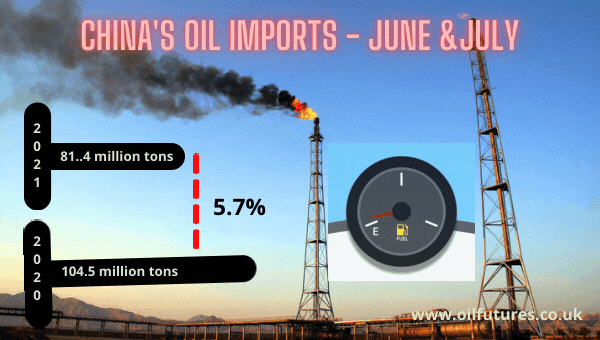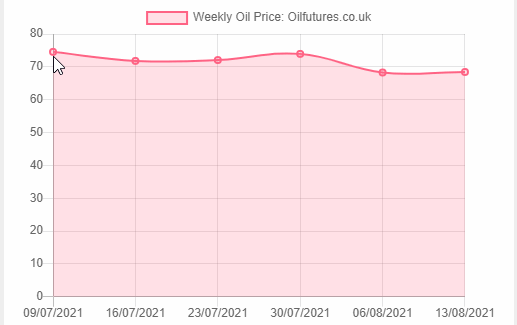Although China managed to control the outbreaks of
the Delta variant of the Covid-19, it could not mitigate the impact on the
economy during the period from July to August. The latest data from the National Bureau of
Statistics of China, released on the eve of the latest OPEC+ meeting, clearly show…
Tuesday, 31 August 2021
Monday, 30 August 2021
Hurricane Ida downgraded: crude oil markets slowly react to the news
The price of crude oil recorded a slight fall on
Monday, perhaps at the news that the Hurricane Ida, which had been battering
the US Gulf Coast on Sunday, has finally been downgraded to a tropical storm. Although the strong winds can still cause mayhem,
the impact on the ordinary lives appears to be…
Sunday, 29 August 2021
Amazing recovery of the price of crude oil
The price of crude oil has been rising for the whole
week, having suffered a 15% loss in the first three week in August. The fall of price by almost $11 a barrel made
some pundits predicting a new crash, something that did not materialise. One of the main factors that sent the price of crude
oil on…
Friday, 27 August 2021
Oil Price: Tropical Storm Ida raises the prospect of crude oil supply crunch in the US
The price of crude oil rose on Friday in line with
short-term supply uncertainties. As of 10:30 GMT, the price of WTI and Brent stood at
$68.45 and $71.98 respectively - with a rise of 1.53% and 1.29%. On political front, the bomb attack by the ISIS-K in
Afghanistan targeting the US troops sent the s…
Wednesday, 25 August 2021
Oil price: API and EIA lift the moods up in the crude oil markets
The price of crude oil appears to have recovered the
losses suffered throughout the last week. It got the much-needed boost this
week when the data from the API, American Petroleum Institute and the EIA, US
Energy Information Administration, showed draws in the US crude oil
inventories. The EIA repo…
Monday, 23 August 2021
Crude oil price: the Taliban factor in the crude oil markets
Crude oil markets made a significant recovery on
Monday, having been through disturbing price fluctuations in the last few days.
As of 18:00 GMT, the price of WTI and Brent stood at $65.52 and $68.60 with a
rise of 5.44% and 5.25% respectively. Since there was no change in the factors that
usually a…
Sunday, 22 August 2021
Iran' Oil Production is up in the hope of reviving the JCPOA
According to the latest report on oil productions by
the member states by the OPEC+, the Iranian crude oil output for July shows an
increase by 28%, compared to the output for the same month last year. The figure for July, 2021 stood at 2.485 million bpd
and it was 1.936 million bpd for the same per…
Friday, 20 August 2021
🤔 Crude Oil Price Fluctuates as if it followed the path of the Sun across the sky!
The oil price is falling and the pattern of fall on
a given day remains puzzling, though. In the past few days it was as if the crude oil
price followed the apparent movement of the Sun across the sky! In the early hours of the day when the markets in
the Asia open, the price picks up only to fall ag…
Thursday, 19 August 2021
Oil price goes down: will the Iranian oil shipment to Lebanon create another crisis?
The price of crude oil was substantially down on
Thursday with WTI and Brent hitting as low as 67.27 and 66.11 respectively as
of 17:30 GMT. Both benchmarks lost over 3.3% in a day. The outbreaks of the Delta variant of the
Coronavirus, coupled with weak economic data from China, have resulted in th…
Wednesday, 18 August 2021
Oil Price: the API reports a modest crude inventory draw - slight recovery in the markets
With the news of a modest crude inventory draw, announced
by the API, American Petroleum Institute, the price of crude oil recovered
slightly from the losses it suffered on Tuesday. As of 09:00 GMT, the price of WTI and Brent stood at
$66.89 and $69.43 respectively. The forecast by the analysts for t…
Tuesday, 17 August 2021
Falling Oil Price: the key factor is China's economic slowdown
The price of crude oil has been falling with no sign
of the trend being reversed, although the rate of fall remains modest. Throughout the past three weeks, analysts were
wondering as to why the price of crude oil started falling despite the
geopolitical risks that had the potential to disrupt the s…
Saturday, 14 August 2021
Voltatility in the oil markets still persists
Crude oil price behaved like the movements of a ping-pong
ball that hit a wooden floor, having fallen from a moderate height, during the
past week – and the two weeks before it; there were endless peaks and troughs
on the screens of traders and investors that result in nothing, when subjected
to co…
Friday, 13 August 2021
Crude Oil Demand: optimism of the OPEC remains unchanged
Despite the presence of volatility in the crude oil
markets, the OPEC is still optimistic about the demand of the commodity during
the next few months of this year and for the entire next year. Although the emergence of the Delta variant of the
Coronavirus has dealt a critical blow to the recovery o…
Wednesday, 11 August 2021
Oil price recovers slightly - very modest rate of rise
The crude oil price that saw a precipitous fall on
Monday recovered lost ground somewhat on Tuesday, perhaps owing to the modest
inventory draw predicted by the API, American Petroleum Institute, for the week
ending August 6. The API said there was a draw of 0.86 million
barrels during the period it…
Tuesday, 10 August 2021
Oil Price and Selling Strategic Reserves: how strategic is the move?
With the rise of crude oil prices in the past few
months, some countries resorting to measures that some analysts thought
unthinkable a few years ago; tapping into their respective Strategic Petroleum
Reserves, SPR, is one of them. Both Japan and South Korea have been commercialising
the SPR recentl…
Monday, 9 August 2021
Oil Price: the need of the hour is a strong catalyst, not endless data crunching
The price of crude oil fell on Monday and the factors
that we thought behind it appear to be at play. In my column on Sunday, I raised the issue of the
price of oil on Monday in the current circumstances. As of 11:00 GMT, WTI and Brent recorded steep fall of
4.14% and 3.96% respectively; the price of…
Sunday, 8 August 2021
Oil Price on Monday: will it reflect the steadily rising tension in the Middle East?
Analysts are keen on watching the developments in
the crude oil markets on Monday, having witnessed a tumultuous week, where the
investor sentiment oscillated between two forms of unpredictability that
corresponded with a sharp fall in price, followed by a fragile recovery. On Tuesday, the API, Amer…
Subscribe to:
Comments (Atom)
Search for Articles
Popular Posts
-
The price stagnation of crude oil continues amid evolving tariff issues between the United States, the world's largest economy, and th...
-
OPEC+ and IEA lock horns... On November 22, 2023, the Organization of the Petroleum Exporting Countries (OPEC) and Russia, collectively know...
-
Global oil prices dropped on Friday before the weekend close, recording a second consecutive week of losses. As of 18:00 GMT, WTI crude stoo...
-
The latest data from the EIA, US Energy Information Administration, suggests that the US had been the largest producer of crude oil in 202...
TOP CATEGORIES
Featured Post
Labels
Crude Oil Prices
(508)
Global Politics & Energy
(508)
Crude Oil Prices
(50)
featured
(8)
Gas Prices
(519)
Global Politics & Energy
(77)
Oil & Gas Market Analysis
(575)
Blog Archive
-
▼
2021
(261)
-
▼
August
(23)
- OPEC+ expresses concern over the demand: China adm...
- Hurricane Ida downgraded: crude oil markets slowly...
- Amazing recovery of the price of crude oil
- Oil Price: Tropical Storm Ida raises the prospect ...
- Oil price: API and EIA lift the moods up in the cr...
- Crude oil price: the Taliban factor in the crude o...
- Iran' Oil Production is up in the hope of reviving...
- 🤔 Crude Oil Price Fluctuates as if it followed t...
- Oil price goes down: will the Iranian oil shipment...
- Oil Price: the API reports a modest crude inventor...
- Falling Oil Price: the key factor is China's econo...
- Voltatility in the oil markets still persists
- Crude Oil Demand: optimism of the OPEC remains unc...
- Oil price recovers slightly - very modest rate of ...
- Oil Price and Selling Strategic Reserves: how stra...
- Oil Price: the need of the hour is a strong cataly...
- Oil Price on Monday: will it reflect the steadily...
- Crude oil markets face a crucial period
- New Iranian president revives the hopes of restart...
- Oil price seasaws and Covid infection rates drive it
- Oil Price: crude oil markets are still shaky despi...
- Oil Price: what really spooked the markets?
- Resistance Axis: is this a resurrected central lin...
-
▼
August
(23)























